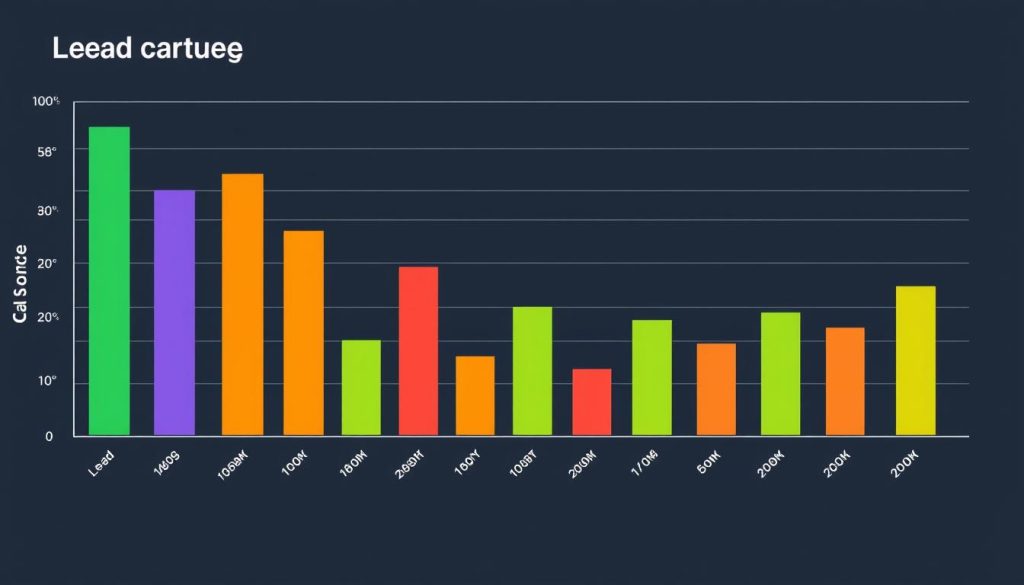In today’s digital landscape, effectively analyzing online lead capture data has become a crucial skill for businesses aiming to drive growth and outpace the competition. By unlocking the power of lead data, marketers and sales teams can make data-driven decisions, optimize their strategies, and boost conversions. This comprehensive guide will delve into the strategies, tools, and best practices for mastering the art of analyzing online lead capture data.
Key Takeaways
- Understand the importance of online lead capture data analysis for business growth
- Discover the competitive advantages of effective data analysis
- Learn about the key metrics and data points to track for lead data optimization
- Explore strategies for leveraging lead data to refine marketing and sales efforts
- Gain insights into essential tools and techniques for data analysis and visualization
Unveiling the Power of Lead Data Analysis
Analyzing online lead capture data can be a game-changer for businesses seeking to drive growth and gain a competitive edge. By understanding the behaviors, preferences, and pain points of potential customers, companies can refine their lead generation strategies, improve targeting and segmentation, and ultimately drive higher conversion rates.
Why Lead Data Matters for Business Growth
In today’s data-driven landscape, lead data holds the keys to unlocking new opportunities for business success. Analyzing this information can provide invaluable insights that inform strategic decision-making and fuel data-driven business growth. From identifying high-value leads to optimizing marketing campaigns, lead data analysis is a powerful tool that savvy organizations are leveraging to gain a competitive advantage.
The Competitive Edge of Effective Data Analysis
Organizations that embrace data-driven strategies and effective data analysis are well-positioned to outmaneuver their competitors. By uncovering insights about lead behavior, preferences, and pain points, businesses can optimize their lead generation strategies and deliver a more personalized, tailored experience to potential customers. This strategic advantage can translate into higher conversion rates, increased revenue, and a stronger market position.

“Lead data analysis is the secret weapon that can transform a good business into a great one. By harnessing the power of data-driven insights, companies can unlock new avenues for growth and stay ahead of the competition.”
Defining and Understanding Lead Capture Data
Before diving into the analysis of lead capture data, it’s crucial to have a clear understanding of what this data entails. Lead capture data encompasses the information gathered from various touchpoints where potential customers interact with your business, such as website forms, email opt-ins, webinars, and social media interactions. This data provides valuable insights into the behavior and attributes of your leads, helping you optimize your marketing and sales strategies.
Key Metrics and Data Points to Track
To gain a comprehensive understanding of your lead generation performance, there are several key metrics and data points that marketers should focus on. These include:
- Lead volume: The total number of leads captured over a specific time period.
- Lead source: The channels or campaigns that are generating the most leads, such as social media, search engine optimization, or email marketing.
- Lead quality: The level of engagement and likelihood of conversion for each lead, based on factors like lead behavior, demographics, and lead score.
- Lead conversion rate: The percentage of leads that successfully convert into customers or sales-qualified leads.
- Cost per lead: The average cost associated with generating a new lead, including advertising, content creation, and lead nurturing efforts.
By closely monitoring these essential data points for analysis, marketers can make data-driven decisions to optimize their lead capture strategies and uncover data-driven marketing insights that drive business growth.
| Metric | Description | Importance |
|---|---|---|
| Lead Volume | The total number of leads captured over a specific time period. | Indicates the overall effectiveness of lead generation efforts and helps set performance goals. |
| Lead Source | The channels or campaigns that are generating the most leads. | Helps identify the most successful lead generation channels and optimize marketing investments. |
| Lead Quality | The level of engagement and likelihood of conversion for each lead. | Enables targeted lead nurturing and sales prioritization to improve conversion rates. |
| Lead Conversion Rate | The percentage of leads that successfully convert into customers or sales-qualified leads. | Measures the overall effectiveness of the lead generation and sales processes. |
| Cost per Lead | The average cost associated with generating a new lead. | Helps optimize marketing budgets and identify the most cost-effective lead generation channels. |

Leveraging Lead Capture Data for Marketing Optimization
As a business, harnessing the power of lead capture data can be a game-changer when it comes to refining your marketing strategies and enhancing customer segmentation. By delving into the wealth of information collected from lead generation efforts, you can uncover invaluable insights that will propel your lead data-driven marketing optimization and lead generation strategy refinement.
Refining Your Lead Generation Strategies
Analyzing lead capture data allows you to identify your most productive lead sources, ensuring you allocate resources effectively. You can pinpoint the channels, campaigns, or tactics that consistently drive high-quality leads, enabling you to double down on what’s working and optimize your lead generation strategy. This data-driven approach empowers you to make informed decisions, leading to more efficient and cost-effective lead acquisition.
Enhancing Customer Segmentation and Targeting
Lead capture data is a goldmine when it comes to customer segmentation and targeting. By scrutinizing the characteristics, behaviors, and preferences of your leads, you can create more accurate and granular customer profiles. This deep understanding of your target audience enables you to craft hyper-personalized marketing campaigns, delivering the right message to the right people at the right time. Leverage this data-driven approach to enhance your customer segmentation and unlock the true potential of your lead data-driven marketing optimization.
“By analyzing lead capture data, businesses can uncover a wealth of insights to refine their marketing strategies and improve customer targeting. This data-driven approach is the key to unlocking the full potential of your marketing efforts.”

Remember, the journey of lead data-driven marketing optimization and lead generation strategy refinement is an ongoing process. Continuously monitoring and analyzing your lead capture data will empower you to make informed decisions, optimize your marketing tactics, and stay ahead of the competition.
Sales Funnel Optimization Through Data-Driven Insights
In the world of digital marketing, lead data analysis doesn’t stop at the initial capture stage. Savvy businesses are now leveraging these valuable insights to optimize their sales funnels and drive higher conversion rates. By unlocking the power of sales funnel optimization using lead data, organizations can identify bottlenecks, enhance lead nurturing, and improve the overall sales process for better revenue generation.
One key aspect of data-driven decision-making for sales is understanding the various stages of the sales funnel and how lead data can inform each step. From initial awareness to final conversion, lead data can help businesses refine their strategies, personalize their outreach, and enhance lead conversion rates across the board.
By analyzing metrics such as lead source, lead behavior, and lead engagement, businesses can gain valuable insights into the effectiveness of their sales funnel. This data-driven approach allows them to identify areas for improvement, optimize their lead nurturing campaigns, and ultimately, increase their sales success rate.

Additionally, lead data analysis can help businesses segment their leads more effectively, enabling them to tailor their sales strategies to the specific needs and preferences of each customer persona. This level of personalization can significantly enhance lead conversion rates and foster stronger, more meaningful relationships with customers.
By embracing the power of sales funnel optimization using lead data, businesses can unlock new levels of growth and profitability. With data-driven insights guiding their decisions, they can streamline their sales processes, deliver more personalized experiences, and ultimately, achieve greater success in the competitive marketplace.
Analyzing Online Lead Capture Data
Effective analysis of online lead capture data requires the right tools and techniques. Marketers and analysts can leverage a variety of data analysis tools and methodologies to extract valuable insights from their lead data, empowering them to make informed decisions and drive business growth.
Essential Tools and Techniques for Data Analysis
When it comes to the online lead capture data analysis process, there are several essential tools and techniques that can be employed:
- Web analytics platforms, such as Google Analytics and Adobe Analytics, provide valuable data on website traffic, user behavior, and lead conversion patterns.
- Customer relationship management (CRM) systems, like Salesforce and HubSpot, enable businesses to track lead activity, sales interactions, and pipeline management.
- Advanced data analysis techniques, including regression analysis, predictive modeling, and segmentation, can uncover deeper insights and trends within the lead data.
- Data visualization tools, such as Tableau and Power BI, help present lead data in a meaningful and easily understandable way, supporting data-driven decision-making.
By leveraging these data analysis tools and techniques, businesses can gain a comprehensive understanding of their online lead capture data, enabling them to optimize their lead generation strategies and improve their overall marketing and sales performance.
| Data Analysis Tool | Key Capabilities | Typical Use Cases |
|---|---|---|
| Google Analytics | Web traffic analysis, user behavior tracking, conversion rate optimization | Identifying high-performing marketing channels, understanding user journeys, and optimizing lead capture forms |
| Salesforce | Lead and contact management, sales pipeline tracking, marketing automation | Managing the lead-to-customer conversion process, segmenting leads, and aligning sales and marketing efforts |
| Tableau | Data visualization, interactive dashboards, advanced analytics | Creating visually compelling reports, identifying trends and patterns, and supporting data-driven decision-making |
“Leveraging the right data analysis tools and techniques is crucial for businesses looking to optimize their online lead capture process and gain a competitive edge in the market.”
By embracing the power of data analysis, businesses can unlock a deeper understanding of their online lead capture data, enabling them to refine their marketing strategies, enhance customer segmentation, and drive sustainable growth.
Identifying and Addressing Data Quality Issues
In the world of lead data analysis, data quality is the cornerstone of success. Poor data quality can lead to unreliable insights, flawed decision-making, and ultimately, lost opportunities for business growth. Identifying and addressing data quality issues is, therefore, a crucial step in improving the integrity of your lead capture data.
Best Practices for Data Cleaning and Validation
To maintain the highest standards of lead data quality, it’s essential to implement robust data cleaning and validation processes. Here are some best practices to consider:
- Regularly audit your data: Conduct periodic reviews to identify missing, incomplete, or inaccurate data points. This will help you pinpoint areas for improvement.
- Implement data validation rules: Establish a set of rules to ensure data consistency, such as checking for valid email formats, phone number patterns, and address formats.
- Leverage data deduplication tools: Identify and merge duplicate records to eliminate redundancies and maintain a clean, consolidated database.
- Incorporate data enrichment: Supplement your lead data with additional contextual information, such as industry, company size, and job titles, to enhance its value and relevance.
- Automate data cleaning processes: Utilize tools and scripts to automate repetitive data cleaning tasks, saving time and reducing the risk of human error.
By improving data integrity through data cleaning and validation, you can unlock the true power of your lead data and gain valuable insights to drive your business forward.
“High-quality data is the foundation for making informed decisions and driving business growth. Investing in data cleaning and validation is a wise investment that pays dividends in the long run.”
Visualizing Lead Data for Better Decision-Making
In the fast-paced world of marketing and sales, transforming raw lead data into meaningful, visually-appealing formats is essential for effective decision-making. Data visualization techniques, including dashboards and reports, allow marketers and sales teams to quickly identify trends, patterns, and opportunities within their lead capture data.
By leveraging lead data visualization, businesses can gain valuable insights that drive data-driven decision making. From tracking lead generation metrics to analyzing customer segmentation, visualizing lead data can provide a clear, concise, and actionable overview of a company’s performance and growth potential.
The Power of Lead Data Dashboards
Well-designed data dashboards serve as a centralized hub for lead data, bringing together key metrics and insights into a single, user-friendly interface. These dashboards can help teams:
- Monitor lead capture and conversion rates in real-time
- Identify high-performing marketing channels and campaigns
- Analyze the effectiveness of lead nurturing and sales strategies
- Uncover opportunities for optimization and growth
Crafting Informative Lead Data Reports
In addition to interactive dashboards, comprehensive data reports can provide a deeper dive into lead data, allowing teams to uncover valuable insights and make informed decisions. These reports can include:
- Lead source and channel performance analysis
- Lead quality and conversion rate trends
- Customer segmentation and targeting analysis
- Sales funnel progression and bottleneck identification
By transforming raw lead data into visually engaging and insightful reports, businesses can empower their teams to make data-driven decisions that drive sustained growth and success.
| Metric | Value | Trend |
|---|---|---|
| Lead Capture Rate | 12.5% | +3.2% (YoY) |
| Lead Conversion Rate | 25% | -1.8% (YoY) |
| Cost per Lead | $42 | -$5 (YoY) |
“Effective data visualization empowers teams to make informed decisions that drive sustainable growth.”
Integrating Lead Data with CRM and Marketing Automation
In the digital age, harnessing the power of lead data is crucial for driving business growth. To truly maximize the potential of this valuable information, it’s essential to integrate lead data with other key systems, such as customer relationship management (CRM) and marketing automation platforms.
Streamlining Data-Driven Processes
By synergizing lead data with CRM and marketing automation, organizations can unlock a wealth of insights that fuel more effective, data-driven marketing and sales processes. This integration allows businesses to:
- Enhance lead qualification and prioritization, ensuring sales teams focus on the most promising prospects.
- Personalize customer experiences through targeted communication and tailored content.
- Automate various marketing and sales workflows, streamlining operations and improving efficiency.
- Gain a holistic view of the customer journey, from initial lead capture to post-purchase interactions.
When lead data is seamlessly integrated with CRM and marketing automation, businesses can drive more informed decision-making, optimize their data-driven marketing and sales processes, and ultimately, achieve greater lead data integration with CRM and marketing automation.
| Benefits of Integrating Lead Data | Key Metrics to Track |
|---|---|
| Enhanced lead qualification and prioritization | Lead conversion rates |
| Personalized customer experiences | Lead-to-customer ratio |
| Automated marketing and sales workflows | Customer lifetime value (CLV) |
| Holistic view of the customer journey | Marketing qualified leads (MQLs) |
By synergizing lead data for holistic insights, organizations can unlock the true potential of their data-driven marketing and sales processes, driving sustainable growth and staying ahead of the competition.
“Integrating lead data with CRM and marketing automation is a game-changer for businesses looking to optimize their customer acquisition and retention strategies.”
Conclusion
As we conclude our exploration of analyzing online lead capture data, it’s clear that mastering this skill is a transformative asset for businesses seeking to drive growth, outpace the competition, and deliver exceptional customer experiences. By implementing the strategies, tools, and best practices outlined in this guide, organizations can unlock the true power of their lead data and make informed, data-driven decisions that propel their success.
The key takeaways for analyzing online lead capture data include optimizing marketing and sales strategies, enhancing customer segmentation and targeting, and driving business growth through data-driven decision making. By leveraging the insights gleaned from lead data, companies can refine their lead generation efforts, streamline their sales funnel, and ultimately, foster stronger, more profitable relationships with their customer base.
Ultimately, the ability to effectively analyze online lead capture data is a critical competency for businesses of all sizes, across industries. By embracing this data-driven approach, organizations can stay ahead of the curve, adapt to evolving market dynamics, and position themselves for long-term, sustainable growth in the digital age.




